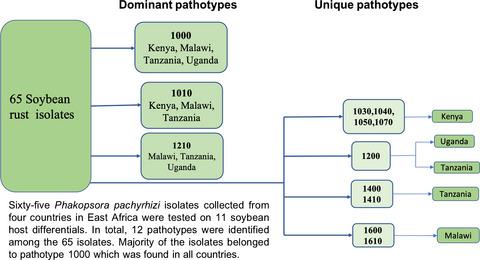当前位置:
X-MOL 学术
›
Plant Pathol.
›
论文详情
Our official English website, www.x-mol.net, welcomes your
feedback! (Note: you will need to create a separate account there.)
Diversity and distribution of pathotypes of the soybean rust fungus Phakopsora pachyrhizi in East Africa
Plant Pathology ( IF 2.3 ) Pub Date : 2020-11-29 , DOI: 10.1111/ppa.13324 Harun M. Murithi 1 , Rafael M. Soares 2 , George Mahuku 1 , H. Peter Esse 3 , Matthieu H. A. J. Joosten 4
Plant Pathology ( IF 2.3 ) Pub Date : 2020-11-29 , DOI: 10.1111/ppa.13324 Harun M. Murithi 1 , Rafael M. Soares 2 , George Mahuku 1 , H. Peter Esse 3 , Matthieu H. A. J. Joosten 4
Affiliation

|
Phakopsora pachyrhizi is a biotrophic fungus that causes rust on soybean, leading to devastating yield losses. Development of resistant cultivars for deployment in different geographic regions requires a comprehensive understanding of the prevalent P. pachyrhizi pathotypes. To determine the pathotypes existing in four East African countries, 65 isolates were tested on 11 soybean host differentials. In addition, the virulence spectrum of isolates collected from the same region over multiple years was compared. The majority of the isolates (54%) belonged to pathotype 1000, which was found in all countries. The pathotypes with the most complex virulence spectrum, which comprised isolates from Kenya and Malawi, were virulent on four differentials. All pathotypes were virulent on soybean genotypes carrying the Rpp1 resistance gene to P. pachyrhizi, but they were avirulent on cultivars carrying the Rpp1b, Rpp2, or Rpp3 gene, as well as on cultivar No6‐12‐1 that carries Rpp2, Rpp4, and Rpp5. Two of the pathotypes were virulent on cultivar UG 5 that carries Rpp1 and Rpp3 and on Hyuuga that carries Rpp3 and Rpp5. The isolates collected from different countries differed in their virulence spectrum across the years. Shannon's index (H) and Simpson's index (S) of diversity indicated that the isolates from Malawi were more diverse (H = 1.55, S = 0.90) while those from Uganda had lower diversity (H = 0.78, S = 0.46 ). The Rpp genes that were found to provide resistance to all pathotypes of P. pachyrhizi can be employed for soybean breeding aimed at durable rust resistance.
中文翻译:

东非大豆锈病真菌Phakopsora pachyrhizi病原菌的多样性和分布
菜豆(Phakopsora pachyrhizi)是一种生物营养性真菌,可导致大豆生锈,导致毁灭性的产量损失。为了在不同的地理区域内部署而开发抗性品种,需要对流行的P有一个全面的了解。ach子病型。为了确定四个东非国家中存在的致病型,对11种大豆寄主的差异检测了65种分离株。另外,比较了从同一地区收集的多年分离株的毒力谱。大多数分离株(54%)属于1000型,在所有国家都发现。具有最复杂毒力谱的致病型,包括来自肯尼亚和马拉维的分离株,在四个差异上具有毒性。所有的致病型都对携带大豆基因型剧毒RPP1抗性基因P。pachyrhizi,但在携带Rpp1b,Rpp2或Rpp3的品种上却无毒基因以及携带Rpp2,Rpp4和Rpp5的6-12-1品种。的致病型中的两个是剧毒上携带品种UG 5 R-PP1和RPP3和Hyuuga携带RPP3和Rpp5。多年来,从不同国家收集的分离株的毒力谱有所不同。Shannon多样性指数(H)和Simpson多样性指数(S)表明,来自马拉维的分离株具有更高的多样性(H = 1.55,S = 0.90),而来自乌干达的分离株具有较低的多样性(H = 0.78,S = 0.46)。这已发现Rpp基因可对P的所有病原体产生抗性。Pachyrhizi可用于大豆育种,以实现持久的防锈性。
更新日期:2020-11-29
中文翻译:

东非大豆锈病真菌Phakopsora pachyrhizi病原菌的多样性和分布
菜豆(Phakopsora pachyrhizi)是一种生物营养性真菌,可导致大豆生锈,导致毁灭性的产量损失。为了在不同的地理区域内部署而开发抗性品种,需要对流行的P有一个全面的了解。ach子病型。为了确定四个东非国家中存在的致病型,对11种大豆寄主的差异检测了65种分离株。另外,比较了从同一地区收集的多年分离株的毒力谱。大多数分离株(54%)属于1000型,在所有国家都发现。具有最复杂毒力谱的致病型,包括来自肯尼亚和马拉维的分离株,在四个差异上具有毒性。所有的致病型都对携带大豆基因型剧毒RPP1抗性基因P。pachyrhizi,但在携带Rpp1b,Rpp2或Rpp3的品种上却无毒基因以及携带Rpp2,Rpp4和Rpp5的6-12-1品种。的致病型中的两个是剧毒上携带品种UG 5 R-PP1和RPP3和Hyuuga携带RPP3和Rpp5。多年来,从不同国家收集的分离株的毒力谱有所不同。Shannon多样性指数(H)和Simpson多样性指数(S)表明,来自马拉维的分离株具有更高的多样性(H = 1.55,S = 0.90),而来自乌干达的分离株具有较低的多样性(H = 0.78,S = 0.46)。这已发现Rpp基因可对P的所有病原体产生抗性。Pachyrhizi可用于大豆育种,以实现持久的防锈性。











































 京公网安备 11010802027423号
京公网安备 11010802027423号